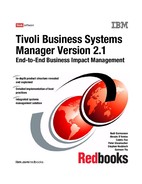
114 Tivoli Business Systems Manager Version 2.1: End-to-End Business Impact Management
4.1 Java console
The Java console is the primary interface for most operators that use IBM Tivoli
Business Systems Manager. The conceptual connectivity of the Java console is
shown in Figure 4-1.
Figure 4-1 Java console structure
All Java consoles communicate with the Console Server, where the
authentication is performed. The Console Server is the one that actually
accesses the database.
The Java console is launched from the IBM Tivoli Business Systems Manager
icon shown in Figure 4-2.
Figure 4-2 IBM Tivoli Business Systems Manager icon
When it launches, it prompts you for a user ID, password, and the host name of
the Console Server, as shown in Figure 4-3 on page 115. The user ID will be
authenticated to the Windows user account of the Console Server. The user also
must be a member of IBM Tivoli Business Systems Manager administrative
groups, which determine the user’s authority within the console.
Console Server
Database Server
Java Console
Java Console
Java Console

116 Tivoli Business Systems Manager Version 2.1: End-to-End Business Impact Management
The left side of the welcome screen shows the list of Business Systems that a
user is authorized to see. Depending on the user’s authority, more or fewer items
may be listed.
The primary menu is the Console menu. The menu shown in Figure 4-5 is for a
Super Administrator, which has all authority. Some menu items may not appear
for other types of administrators.
Figure 4-5 Primary Menu for Super Administrator
Workspaces are discussed in Chapter 13, “Setting up roles and security,” on
page 421. This relates to a pre-customized display that you can store across
logon sessions. You can keep the setting of the open windows and its status in
the workspaces.
Special windows that can be displayed from this menu:
Task monitor Shows tasks that have been executed and the
latest results.
Resource type window Shows the various IBM Tivoli Business Systems
Manager resource types (object classes). You can
modify some of their settings.
All Resources Shows the physical object hierarchy that IBM
Tivoli Business Systems Manager is managing.
Preferences Used for setting various console properties.
Administrator preferences Shows the main settings for this console session.
Figure 4-6 on page 117 shows a sample console with both the Business
Systems and All Resources views partially expanded.

Chapter 4. User interface 117
Figure 4-6 Expanded console
Here you can see various managed resources and their status. Any abnormal
status is indicated using a color-coded sign over the icon. You can view each
object’s properties by right-clicking the object and selecting Properties. A
sample property display for a DB2InstanceManager is shown in Figure 4-7 on
page 118.

118 Tivoli Business Systems Manager Version 2.1: End-to-End Business Impact Management
Figure 4-7 Property page of a DB2InstanceManager object
In the property display you can see the events and exceptions that relate to this
object, as well as its attributes and other useful information.
A lesser-known feature of the Java console is its ability to go into debug mode,
which provides additional information for objects and their attributes. Invoke
debug mode using the key combination Ctrl+Shift+F12. In debug mode, the
expanded desktop in Figure 4-6 on page 117 looks like Figure 4-8 on page 119.
..................Content has been hidden....................
You can't read the all page of ebook, please click here login for view all page.

